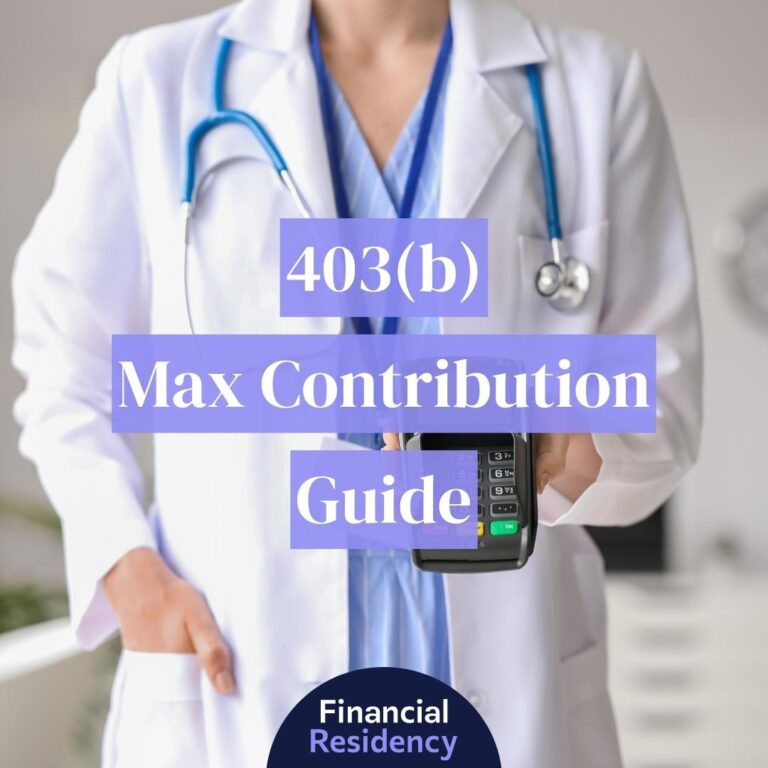Financial Residency’s mission is helping early-career medical professionals take charge of their personal finances, build their financial security, and grow their net worth.
Investing is one of the best ways to meet your goals, enhance your quality of life, and accelerate your journey to financial freedom.
Whether you’re a medical student or a seasoned physician, this guide will educate you on the best investing strategies and help you feel confident in your investments.
How To Start Investing
In the simplest terms, when you have excess cash flow, you should make a plan to invest those funds. But there are a few steps you should take before you start investing:
- Get insured: You can invest in yourself and your family by purchasing insurance. As high income earners, physicians have a lot to protect. Consider purchasing life insurance, disability insurance, malpractice insurance, and umbrella insurance to shield yourself, your family, and your practice from risk.
- Stock your emergency fund: Build an emergency fund with enough money to cover 6-12 months of essential expenses. It’s wise to keep this money in a high-yield savings account or FDIC-insured money market account. Both options will give you liquidity your and help you take advantage of compound interest.
- Pay down debt: If you have student loans or significant consumer debt, you should also focus on your repayment In some cases, it may make sense to pay off all your debt before investing a dollar in the stock market, but there is no one-size-fits-all.
- Establish your risk tolerance: Financial advisors will ask questions to determine your risk tolerance. Highly motivated investors with a high capacity for risk have an Aggressive Risk Tolerance whereas cautious investors are more likely to have a Conservative Risk Tolerance. Investors who like a mix of high and low-risk investments have a Moderate Risk Tolerance. Your risk tolerance will inform the types of investments you’re willing to make.
- Factor in taxes: Make sure you’re aware of your tax liability. You can work with a financial advisor, tax attorney, Certified Public Account (CPA), or other tax professional to protect yourself against a major bill. The best financial professionals will set up a sustainable savings model that allows you to put away money for taxes and maximize your available tax deductions through tax-efficient strategies.
- Create an investment policy statement: Your investment policy statement is the roadmap for your investments. These documents outline your rules for investing, your investment goals and objectives, and the strategies your portfolio manager can use to meet your objectives.
Best Physician Investments
You have virtually endless investment opportunities to choose from, and the right investment vehicle for you depends on your unique situation and preferences.
Generally speaking here are some of the best investments for doctors:
- Private practice: One way to build your wealth as a physician is to invest in a private practice. You can do this by starting your own practice or investing in a successful practice that already exists.
- Medical side hustle: Consider putting your skills to use with a medically-adjacent side hustle. There are plenty of side hustles for physicians, and some can provide you with passive income.
- Stock market: Diversify your investment portfolio by investing in stocks of reputable companies, taking advantage of potential long-term growth and dividends.
- Mutual funds: Mitigate risk by investing in a professionally managed portfolio of stocks, bonds, and other securities.
- Index funds: These low-cost investment options provide broad market exposure and can be an effective long-term investment strategy.
- Bonds: Invest in fixed-income securities such as government or corporate bonds for a more conservative and predictable investment option.
- Real estate: Consider getting into real estate investing to generate passive income and potentially benefit from property appreciation. It’s a great diversification tool for your portfolio.
Investing Tips for Doctors
1. Employ the Dollar-Cost-Averaging Strategy
If we can provide one salient tip on investing it would be don’t try to time the market.
Research shows that investors who try to time the market don’t realize higher returns. Also, given the nature of the market, there is no way to tell what will happen in the markets tomorrow, let alone a year from now.
Bear and bull markets have little impact on the way seasoned investors play the market. In general, the most lucrative returns come from keeping money in the market and weathering the volatility.
You can use a dollar-cost-averaging strategy to help protect your investments. It’s been proven to be one of the best ways to build wealth over time.
This investing technique entails investing the same amount of money regularly over time. Because you buy into an investment at different price points, you pay an average of its changing prices over time. Your 403(b) or 401(k) retirement plans already do this for you.
In general, putting the same amount of money into the market regularly has larger returns than putting in a lump sum once.
2. Diversify Your Investments
When you earn a high income, it’s important to understand the difference between an asset location strategy and an asset allocation strategy.
Your asset allocation is the diversity of your investments, typically represented by a percentage based on the different asset classes in your portfolio.
For example, if you have $200,000 in stocks and $300,000 in bonds, your asset allocation would be 40% stocks ($200,000/$500,000) and 60% bonds ($300,000/$500,000).
When you’re younger, you’ll probably have a more aggressive asset allocation, with growth-oriented investments such as stocks.
As you near retirement, your asset allocation typically becomes more conservative and may switch to a higher percentage of bonds than stocks. Asset allocation is based on your financial goals, time horizon, and risk tolerance.
On the other hand, your asset location strategy is where you hold a specific investment. You can hold investments in a pre-tax retirement account, post-tax retirement account, or a taxable brokerage account.
The key to your asset location strategy is understanding how different types of investments are taxed and what that means for your tax bill when you hold them in the various accounts available to you.
3. Invest in Tax Efficient Assets
When thinking about an asset location strategy, it is also important to understand the difference between tax-efficient assets and tax-inefficient assets.
An investment is considered tax-efficient if it doesn’t generate ordinary taxable income regularly.
For example, stocks held for the long-term and passive index funds such as an S&P 500 index are considered tax-efficient investments.
Stocks and index funds typically pay dividends quarterly, and these dividends are usually considered qualified dividends. If a dividend is qualified, that means you pay tax on the dividend at your more favorable long-term capital gain rate.
Stocks held for the long term are also considered tax-efficient because when you sell a long-term asset, you pay tax at the long-term capital gain rate.
Notice how you are not paying your ordinary income tax rate in either of these situations, and you are only paying tax when you sell the stock for a gain or when you receive a dividend.
A tax-inefficient investment is one where you will be paying taxes at your ordinary income tax rates for the income the asset generates regularly.
Examples of tax-inefficient investments include bonds, actively traded, high-volume mutual funds, and REITs. Bonds are considered tax-inefficient because they pay you interest on an annual basis, and the interest is considered ordinary income.
This means bond interest is taxed at your marginal tax rates, so if you are a physician in a high marginal tax bracket, you will be paying a high tax rate on your bond interest, and you will be paying it annually.
When mutual funds are traded frequently, they generate tons of short-term capital gains or
losses because the fund is not holding assets for a period longer than one year. Short-term capital gains are taxed at your ordinary-income tax rate, so if a mutual fund is trading frequently, you likely will be paying tax more frequently than you need to.
REITs pay dividends to their unitholders and are considered tax-inefficient because these dividends are typically considered ordinary income which means you will pay tax at your ordinary-income rate.
Passive vs. Active Investing
Passive investing is a buy-and-hold technique and involves dollar-cost-averaging. Once you decide on an asset allocation, it doesn’t change for years at a time. Because there is less trading, this strategy is typically more tax-efficient than an active investing strategy.
Most passive investors use index funds, exchange-traded funds (ETFs), or mutual funds. In general, passive investing is the better option for beginner investors because it’s a more low-cost strategy.
Passive investments typically have lower costs because you’re not paying high management fees for an investment manager to pick stocks. As such, passive investing historically has higher real returns compared to active investing.
Active investing is more involved than passive investing because a portfolio manager is constantly running an analysis on what stocks to buy or sell. The active investing strategy is typically more expensive than a passive investing strategy as you’re paying this manager for their time and expertise.
There’s always a risk when investing. An active investing strategy exposes you to more risk because you’re at the mercy of the manager’s expertise and potential for error.
Active investing has a place in some investors’ overall strategy. Because of their ability to use advanced investing techniques, such as short sales and put options, active management could help investors hedge themselves against loss.
Many investors use both active and passive strategies.
Decide Where To Invest
Deciding where to invest is simple if you know the general order of accounts to save into.
- First, invest in yourself by filling your emergency fund and creating a buffer in your checking account.
- If you’re offered a match on your savings into a retirement plan through your employer, such as a 401(k) or 403(b), this is the first place you should be investing. Take the free money to boost your retirement savings.
- Once you’re saving enough into your retirement plan to get the full match, you can start exploring other avenues for investing such as IRAs, brokerage accounts, health savings accounts, 529 plans, and alternative investments such as real estate.
Investing Limits for Physicians
There are two limits to how much you can invest:
- What your cash flow allows, accounting for your other goals
- The limits placed on how much you can save into each account type
If you have $100 of extra cash flow each month, you can invest up to $100. This sounds simple, however, many people invest more than they can afford, and in the end, they sell some of their investments to support their cash flow needs.
Each year, IRS updates the maximum amount you can save in your employer-sponsored retirement accounts and IRAs.
The 2023 contribution limits are:
| Employer-Sponsored Accounts (401(k), 403(b), etc.) | IRAs (Traditional & Roth) | |
| Contribution Limit | $22,500 | $6,500 |
| Additional Contribution Limit for age 50+ | $6,500 | $7,500 |
These limits only apply to the amount you save and do not include employer contributions from your match.
Consider Working with a Financial Advisor
At some point doing the analysis, research, and decision making for your investments may become overwhelming.
Unless you’re willing to take on the task of managing your own money, you may want to consider outsourcing this task to a professional.
Almost everyone can provide financial advice, but not everyone is qualified. Any person with a podcast or a blog can market themselves as a financial advisor, but it doesn’t mean they hold the necessary certifications to demonstrate their education in the field.
In general, we recommend taking financial advice from individuals with clear certifications such as CFA, CFP, and CIMA. FINRA maintains directories of brokers, firms, financial planners, and investment advisors.
The directory details any disciplinary actions and complaints, so you can feel confident you have all the available information.
Hiring a financial advisor can free up the time and energy of managing your investments. They can also offer a deeper level of understanding and expertise that DIY investors may not possess.
We recommend seeking a financial advisor if you’re ready to start planning for the future but have no idea where to begin. Financial advisors work on a variety of payment structures, including fee-only, commission, and a percentage of total assets managed.
Fee-only advisors are the most likely to provide unbiased opinions because they aren’t in a position to earn money on your investments.
Frequently Asked Questions
What is the biggest risk in investing?
The biggest risk of investing is the chance of losing your money.
There are a few common risks of investing. We’ve defined them below.
- Company risk: Company risk occurs when the stock issuer doesn’t realize the promised investment returns. Mutual funds and ETFs mitigate company risk by diversifying investments.
- Volatility and market risk: The market can change in an instant, which has a direct impact on the value of stocks. You can build a portfolio that fortifies you against volatility.
- Opportunity cost: You can counteract opportunity cost by having an asset allocation strategy that considers growth and value stock options.
- Liquidity risk: Some assets are more liquid than others. You can minimize liquidity risk by building a diversified portfolio.
Should I invest in cryptocurrency?
Whether or not you should invest in cryptocurrency comes down to your risk tolerance and education in the space. There are a number of risks when you invest in cryptocurrency.
In general, we recommend cryptocurrency to seasoned investors who have a deep understanding of the nuances of the blockchain. The more knowledgeable you are, the less likely you are to be taken advantage of.
Should I use an investing app?
Investing apps let you move around smaller amounts of money, so you get experience investing without needing much money to start.
Because investing apps only require a little bit of money, you’ll be able to use your online account to complement your more strategic investing portfolio.
These apps can help you find ways to learn and have fun with saving and investing without risking losing large amounts of money.
What are some concerns for doctors investing in stocks?
Compared to their peers, doctors have a relatively short earning career due to all their years spent in medical school and training. As such, they may feel the need to play catch up with their net worth, which can lead to poor investment choices.
Physicians also need to consider any conflicts of interest in their investments. Many of the recognizable stocks and index funds follow healthcare and pharmaceutical trends.
Physicians have an ethical responsibility to disclose any potential conflicts of interest to their patients, such as investing in the manufacturers of the drugs they prescribe.
Doctors may also be privy to confidential information not available to the general public, which may open them up to insider trading concerns.




